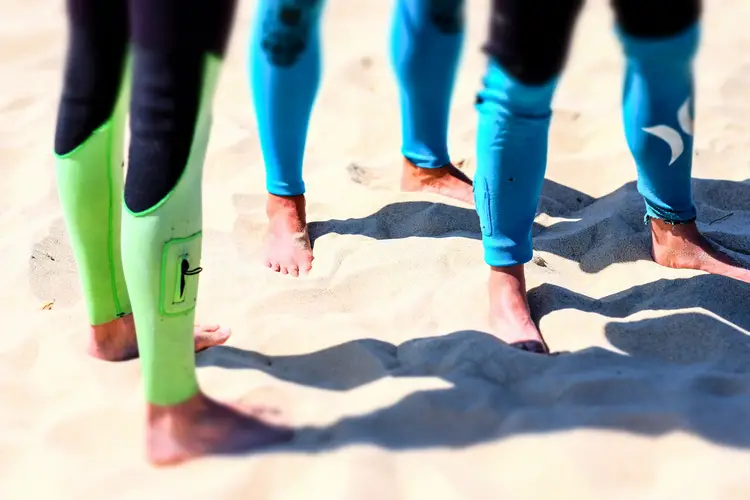
The depth a person can dive without a wetsuit depends on various factors, such as water temperature, individual physical fitness, and diving experience. In general, cold water reduces a person’s ability to dive deeper, as the body loses heat faster, and can lead to hypothermia.
If the water temperature is above 86 degrees Fahrenheit (30 degrees Celsius), a person may be able to dive comfortably without a wetsuit. However, as the temperature drops, the depth at which a person can comfortably dive decreases as well.
In colder water, a person’s ability to dive deeper without a wetsuit is limited to avoid the risks of hypothermia. A rough guideline for safe diving is to limit the depth to 20-30 feet (6-9 meters) without a wetsuit, depending on the water temperature. Beyond that depth, the water pressure, and the temperature can become dangerous for an unprotected diver.
It’s essential to note that diving without a wetsuit can be dangerous in cold water and is not recommended. Wetsuits provide thermal protection, buoyancy, and protection against scrapes, stings, and bites from marine life.
Can you dive without a wetsuit?
Humans can certainly dive without a wetsuit, but it is important to consider the factors mentioned earlier, such as water temperature and individual comfort levels.
Diving without a wetsuit is more common in warm-water environments where the water temperature is comfortable for extended periods. In such cases, divers may choose to forgo wearing a wetsuit.
However, it’s important to note that wetsuits provide benefits such as thermal insulation, protection against the elements and marine life, and buoyancy control, so they are commonly used in diving to enhance safety and comfort.
At what depth do you need a wetsuit?
For shallow dives of less than 10-20 feet (3-6 meters) in warm waters, divers may be able to get away with using a rash guard or swimwear. However, as the depth increases, the water temperature decreases, and a wetsuit becomes necessary to provide thermal insulation and protect the body from the cold.
The need for a wetsuit depends on several factors, including water temperature, the duration of the dive, and the individual’s cold tolerance. Generally speaking, a wetsuit becomes necessary as the water temperature drops below 78°F (25°C).
For dives between 20-40 feet (6-12 meters), a wetsuit with a thickness of 3mm is typically recommended. For dives between 40-80 feet (12-24 meters), a wetsuit with a thickness of 5-7mm is generally preferred, while deeper dives may require a thicker suit or a drysuit.
It’s important to note that the water temperature can vary widely depending on location, season, and depth, so it’s always best to consult local experts and follow their recommendations when it comes to selecting the appropriate wetsuit for a particular dive.
What to do if you don’t have a wetsuit?
If you don’t have a wetsuit and are planning to go for a dive or spend extended periods in cold water, there are a few things you can do to help stay warm:
- Layer your clothing: Wearing multiple layers of clothing can help trap air between the layers, which can act as insulation and keep you warmer. Start with a base layer made of moisture-wicking material, add a middle layer of fleece or wool for insulation, and top it off with a windproof outer layer.
- Stay active: Physical activity generates body heat, so if you’re feeling cold, try to stay active by swimming, snorkeling, or moving around.
- Stay close to the surface: The deeper you go, the colder the water gets, so staying close to the surface can help keep you warmer.
- Take breaks: If you’re feeling too cold, take a break on shore or in a nearby shelter to warm up.
- Stay hydrated: Drinking warm fluids can help keep you warm from the inside.
- Avoid extended exposure: If the water is too cold, it’s best to avoid extended exposure altogether. Know your limits and be prepared to call off the dive if you start feeling too cold or uncomfortable.
It’s important to note that these tips are not a substitute for a wetsuit, which provides insulation, buoyancy, and protection against the elements and marine life. If you’re planning to dive regularly or in colder water, investing in a wetsuit is highly recommended for safety and comfort.
What can I wear if I dont have a wetsuit?
If you don’t have a wetsuit, there are several items of clothing that you can wear to help keep you warm while in the water. Here are some suggestions:
- Rash guard: A rash guard is a type of shirt made from quick-drying, moisture-wicking material that helps protect your skin from sunburn and chafing. It also provides a thin layer of insulation, which can help keep you slightly warmer in the water.
- Wetsuit vest: A wetsuit vest covers your torso and provides additional insulation while leaving your arms free for mobility. It’s a good option for those who don’t want to wear a full wetsuit but need some extra warmth.
- Swim shorts: If you’re only planning to be in the water for a short time or in warmer conditions, you can wear swim shorts or board shorts. However, keep in mind that these types of shorts offer very little insulation, so they may not be suitable for colder water or extended periods in the water.
- Neoprene socks and gloves: If your feet and hands get cold easily, neoprene socks and gloves can help keep them warm. These items are made from the same material as wetsuits and provide additional insulation to these extremities.
Remember that these items are not a substitute for a proper wetsuit and may not provide enough warmth and protection in colder water or for extended periods of time in the water. If you plan to dive regularly or in colder water, it’s recommended to invest in a wetsuit for safety and comfort.
I hope you enjoyed this article about how deep can you dive without a wetsuit?
I’d love to hear from you. Tell us about your adventures of diving and snorkelling. Please use the comments section below. Please also share your photos. Either from your underwater cameras or videos from your waterproof go-pro’s!
If this article hasn’t answered all of your questions. If you have more questions either about snorkelling or scuba diving (or specifically about how deep can you dive without a wetsuit?), please comment below with your questions.
There will also be many more articles about scuba and scuba diving safety tips (and on snorkelling too) for you to read and learn about this fabulous sport.
Have fun and be safe!





